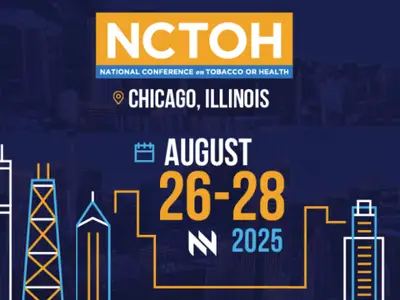National Conference on Tobacco or Health (NCTOH) 2025
Date
Location
Sheraton Grand Chicago Riverwalk
301 E North Water St
Chicago, IL 60611
United States
From August 26–28, public health professionals from around the country will gather to share insights, innovations, and best practices to help reduce tobacco use at this year’s National Conference on Tobacco or Health (NCTOH). The conference will host presentations from ten program tracks, including tobacco and addiction science, evaluation and surveillance, communications and media, youth and young adults, and more.
RTI experts are leading twelve session presentations on topics ranging from campaign evaluation to data collection methodologies to the impact of policy changes. See the full list of presentations below, and learn more about RTI’s nicotine and tobacco research.
RTI Sessions
Estimating the Impact of New York’s 2023 Cigarette Tax Increase on Cigarette Sales and Quitline Calls
Tuesday, August 26 | 1:45–3:00 PM CT
Presenting Author: Mary Catharine McKeithen
Co-authors: Doris Gammon, Nathan Mann, Meera Sumith, Betty Brown, James Nonnemaker
This study aimed to assess the short-term changes in retail cigarette sales and Quitline calls in New York associated with the New York State cigarette excise tax increase in September 2023 to help document the impact of the tax increase, including changes in consumer behavior and quit attempts. Using single-group interrupted time series analysis, we estimated changes in cigarette price per pack and pack sales and Quitline utilization metrics. Average price per cigarette pack overall significantly increased after the tax increase by $1.13, more than the excise tax increase. Weekly pack sales overall significantly decreased by 567,269 packs per week. We did not find increased use of the NYS Quitline during the first 10 months following the tax increase. These results indicate that people who smoke may be quitting or smoking less or potentially looking for alternate sources of cigarettes.
Sexual Orientation and Gender Minority Discrimination and Tobacco Use Among High School Students in California
Tuesday, August 26 | 1:45–3:00 PM CT
Presenting Authors: Lauren Dutra, Chelci Harris
This presentation, which is part of a breakout during the larger Contributing factors to Nicotine Use among sexual and gender minority youth and young adults session, presents findings from the California Youth Tobacco Survey (CYTS; 2023 and 2024) on the relationship between sexual-orientation- and gender-based discrimination and susceptibility to use of vapes, cigarettes, and little cigars/cigarillos among the 8th, 10th, and 12th graders who participated in the CYTS. Findings suggest a relationship between these types of discrimination and susceptibility to tobacco use.
Advancing Tobacco and Nicotine Surveillance: Leveraging Address-Based Sampling and Data Collection Methods for Statewide Adult Tobacco Surveys
Tuesday, August 26 | 3:30–4:45 PM CT
Presenting Authors: Michelle Cavazos, Burton Levine
Co-authors: Claudia Bohner, Meredith Hennon
Monitoring tobacco and nicotine product use behaviors and attitudes is an integral part of state tobacco control programs’ comprehensive efforts to reduce the negative health and economic impact of tobacco and nicotine use. State tobacco control programs face challenges in collecting representative surveillance data due to a range of factors that have changed over time, which necessitate surveillance efforts that are adaptable to changes in the population’s responsiveness to survey recruitment and finite resources for data collection. This panel brings together panelists from the Bureau of Tobacco Free Florida, the Utah Tobacco Prevention and Control Program, and their independent evaluator, RTI International, to highlight programmatic data needs and considerations, surveillance sampling approaches and data collection methodologies to maximize survey response, and utilization of surveillance data to monitor programmatic progress.
Changes in ENDS Sales, Availability, and Nicotine Concentration Associated with Massachusetts’s Flavored Tobacco Sales Restriction and ENDS Nicotine Concentration Limit
Wednesday, August 27 | 3:30–4:45 PM CT
Presenting Author: Jennifer Gaber
Co-authors: Betty Brown, Alex Liber, Gray Spinks, James Nonnemaker, Morgan Whitney, Doris Gammon, Xu Wang, Ashley Ross
In 2019, Massachusetts (MA) implemented a ban on all sales of electronic nicotine delivery systems (ENDS), followed by a more focused sales restriction on ENDS with non-tobacco flavors and/or with nicotine >35 mg/mL. This study used ENDS sales data for MA and Indiana (IN)—a comparison state with no restrictions—to assess changes in sales, availability (number of unique products), and average nicotine strength, overall, by ENDS type, and by combined flavor and nicotine restriction status. The policy was associated with reduced average ENDS nicotine strength in MA and appears to have attenuated the rise of flavored, high-nicotine disposable ENDS compared with IN. However, ENDS with restricted nicotine strength continued to be introduced, particularly among disposables. Findings can inform regulatory actions and may suggest a need for more education focused on high nicotine strengths.
Leveraging Community Partnerships to Influence Local Policy Change: Associations Between Community Partner Engagement and Tobacco Prevention and Control Policy Outcomes
Thursday, August 28 | 8:30–9:45 AM CT
Presenting Author: Michelle Rojas
Co-authors: Juliet Sheridan, Andrew Freeman, Meredith Hennon
This study investigates the impact of local Florida community coalition involvement over a three-year period in tobacco prevention and control (TPC) policy initiatives intended to lead to policy change. Analyses described changes in coalition characteristics and activities over time and identified correlations between specific characteristics and activities. Findings inform effective pathways to leveraging coalitions in policy-related efforts at the local level.
The New Kids on The Block - Using Age Prediction Algorithms to Analyze Reddit Conversations about Nicotine Pouch Brands Among Youth and Adults
Thursday, August 28 | 8:30–9:45 AM CT
Presenting Author: Glen Szczypka
Co-authors: Stephanie McInnis, Jamie Guillory, Margaret Moakley, Amanda Konet, Ryan Haughney, Meredith Hennon
Researchers applied machine learning to predict the age of Reddit users discussing top nicotine pouch brands, revealing differences in how youth and adults talk about products like Zyn. Youth were more likely to discuss quitting through tapering or going cold turkey, while adults focused on using pouches for smoking cessation and raised concerns about health effects. These findings highlight how age-prediction algorithms can help public health officials better understand consumer behaviors and tailor their interventions accordingly.
Tobacco and Cannabis Use Among Youth in Utah
Thursday, August 28 | 10:00–11:15 AM CT
Presenting Authors: Matt Eggers, Anne-Celine Jeffroy-Meynard
Co-authors: Erik Crankshaw, Brian Cunningham-Rhoads, Claudia Bohner
Utah’s Department of Health and Human Services supports evidence-based programming to prevent tobacco and cannabis use uptake among Utah youth. Effective prevention efforts require an understanding of the prevalence and sociodemographic correlates of tobacco and cannabis use behaviors. Using data from a school-based web survey and paper/pencil questionnaire administered to public school students in Utah, we examined the prevalence and sociodemographic correlates of tobacco and cannabis use behaviors among Utah youth. We found that prevalence of cannabis use among Utah youth was higher than use of any other tobacco product and there is substantial overlap in use of both products. We also identified several sociodemographic differences in cannabis and tobacco use behaviors that were aligned with previous research. These findings underscore the need for interventions to prevent youth uptake of cannabis and tobacco that consider the substantial overlap in use across these products.
*Bold names indicate an RTI expert
RTI Poster Presentations
Billing Medicaid for tobacco cessation: Claims data and provider perspectives on challenges and opportunities
Tuesday, August 26 | 12:30–1:45 PM CT
Presenting Author: Michelle Cavazos
Co-authors: Lindsay Olson, Margaret Moakley, Ashley Brandenburg, Therese Wilson, Caroline Meek
Cigarette use among adults enrolled in Medicaid in Florida is more than twice that of adults with private insurance. We conducted a mixed-methods study to understand tobacco use and billing for cessation resources in Medicaid claims in Florida as well as health care provider perspectives on billing Medicaid for these services. Despite near-comprehensive coverage of cessation treatment, Florida Medicaid claims indicate that only 27.6% of Medicaid-enrolled individuals who use tobacco have a claim for any Medicaid-covered tobacco dependence treatment. Increasing awareness of Medicaid coverage among enrollees and the health care providers who interact with them could increase access to and use of evidence-based cessation treatment within a population that is disproportionately affected by tobacco use and tobacco-related morbidity and mortality.
Exploring Implementation Factors for Smokefree Multiunit Housing Policies in Florida-based Federally Assisted Properties
Tuesday, August 26 | 12:30–1:45 PM CT
Presenting Author: Michelle Rojas
Co-authors: Ashley Brandenburg, Lauren Grattan, Ron Davis
This study describes the landscape of smokefree policies in Florida-based federally assisted multiunit housing through a set of semi-structured interviews with property managers. Many management companies of Florida-based federally assisted properties understand the benefits of and have experience with adopting and enforcing comprehensive smokefree policies but still encounter barriers to policy adoption that can be addressed and overcome with state tobacco control program resources.
Assessing Provider Beliefs and Attitudes on Tobacco-related Policies and Practices at Substance Use and Mental Health Treatment Facilities
Tuesday, August 26 | 5:00–6:30 PM CT
Presenting Author: Anne-Celine Jeffroy-Meynard
Co-authors: Stephen Brown, Brian Cunningham-Rhoads, Claudia Bohner
As part of an evaluation of Utah’s Tobacco Prevention and Control Program, we conducted a qualitative study to assess substance use and mental health services (SUMHS) providers’ beliefs and attitudes regarding tobacco cessation and tobacco-related policies and practices at their respective facilities. We administered a brief questionnaire and conducted key informant interviews with eight Local Substance Abuse Authority regional directors and 17 staff from 10 SUMHS facilities in the state of Utah. Preliminary analysis has found barriers related to clients’ and providers’ lack of prioritization of tobacco cessation and difficulty enforcing tobacco free campus policies. Facilitators have included motivation from state regulations. Findings from this study could inform state health departments and SUMHS organizations of barriers and facilitators to tobacco treatment at SUMHS facilities and strategies to utilize in support of the implementation of tobacco-related policies and practices.
Changes in ENDS sales following Utah’s sales restrictions on high nicotine strength ENDS products
Tuesday, August 26 | 5:00–6:30 PM CT
Presenting Author: Doris Gammon
Co-authors: Jennifer Gaber, Mary Stapleton, Claudia Bohner
In September 2021, Utah implemented a policy restricting sales of Electronic Nicotine Delivery Systems (ENDS) with nicotine levels greater than 3%. Following a legal challenge, the restriction was relaxed in September 2023 to permit sales of ENDS with up to 5% nicotine. We assessed changes in weekly ENDS retail sales by nicotine strength in Utah during December 2020 to December 2023. Prior to any nicotine restrictions in Utah, most ENDS sales had a nicotine strength of 5%. Immediate responses were seen following both policy changes—sales of products with nicotine strength greater than 3% dropped to near zero following the 2021 restriction and sales of products with 5% nicotine immediately increased following the 2023 increase in the maximum nicotine strength threshold. Nonetheless, Utah experienced year-over-year decreases in total ENDS sales since late 2020. Findings can help inform federal, state, and local lawmakers considering implementing ENDS nicotine restrictions.
Thematic Analysis of Social Media Comments About Quitting in Response to the Bureau of Tobacco Free Florida’s Tobacco Cessation Social Media Campaign
Tuesday, August 26 | 5:00–6:30 PM CT
Presenting Authors: Stephanie Lane, Allie Rothschild
Co-authors: Margaret Moakley, Casey Horvitz, Meredith Hennon, Jennifer Duke, Kristin Arnold, Sarah Belanger, Rachel Jara, Barbara Lopez
Public health campaigns readily use social media to disseminate health education content. In turn, campaign posts typically generate reactions by, discussions among, and feedback from users in comment threads. The Bureau of Tobacco Free Florida manages the Tobacco Free Florida adult tobacco cessation campaign, which uses paid and organic social media to reach key audiences. RTI conducted a qualitative analysis of social media comments in response to Tobacco Free Florida campaign ads and posts from 2023 on Facebook, Instagram, and X to better understand audience interaction with campaign content and identify recommendations for future campaigns. Through qualitative coding and thematic analysis, RTI identified two primary themes—quit successes and quit struggles—which prompted largely positive user conversations. This session will review these results and demonstrate the insight provided by a social media thematic content analysis.
*Bold names indicate an RTI expert





